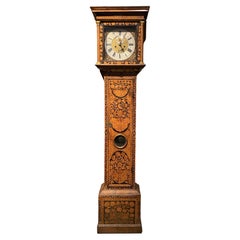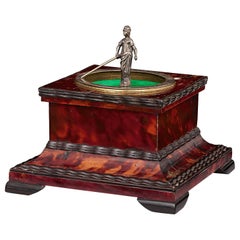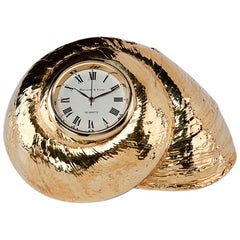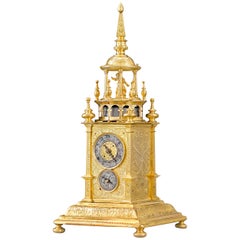17th Century More Clocks
3
to
2
1
3
3
3
1
55
270
160
89
40
77
25
12
8
5
3
6
6
10
3
Height
to
Width
to
3
2
2
1
1
3
1
1
1
Period: 17th Century
Cross-Shaped Chest Clock, Silver, 17th Century, it Presents Restorations
Located in Madrid, ES
Cross-shaped chest clock. Silver. 17th century. It presents restorations.
Portable clock in the shape of a cross with an openwork exterior showing Christian figurative scenes and the movement inside, a dial with a golden band with Roman numerals for the hours, a single needle and an engraved decoration around it, also with a religious theme; on the back, the back of the movement can be seen, with a delicate decoration, also openwork and based on plant motifs reminiscent of classicism, and a band on the case of the piece with simplified plant elements. Outside, we find ourselves on one side with Christ crucified, flanked by the Virgin Mary and Saint John, and the figures are surrounded by a delicate composition based on vegetable scrolls, with an angel's head at the foot of the piece. The other side shows the Resurrection of Jesus, with Christ emerging from the empty tomb...
Category
European Baroque Antique 17th Century More Clocks
Materials
Metal, Silver, Other
William & Mary Floral Marquetry 8-Day Longcase Clock by LeCount 'LeCompte'
Located in Milford, NH
A fine and rare William & Mary long case or grandfather clock by London maker Daniel LeCompte. c.1690, London, the fine marquetry case having oval panels of birds and flowers, the movement signed Daniel LeCount (LeCompte) having a silver chapter ring and seconds dial, brass spandrels of cupids supporting a crown; including key, weights and pendulum. LeCompte was a French Huguenot...
Category
English Antique 17th Century More Clocks
Materials
Brass
Buschman “Minerva” German Horizontal Table Clock
Located in New Orleans, LA
The extraordinary beauty and superior craftsmanship of 17th century German clockmaking is on full display in this exceptionally rare horizontal tabletop timepiece dating to 1650 Augsburg. Created by Johannes Buschman the Younger, the eminent Buschman family of clockmakers are lauded for designing some of the finest timepieces to ever be created in the South German town of Augsburg during the late Renaissance and early Modern periods. A finely moulded ebony and turtleshell casing veneered in a mottled red hue holds the clock’s fusée and chain movement with verge escapement and balance with hogs-bristle regulation. A silver figure of Minerva, Roman goddess of war and wisdom, centers the Roman numeral-engraved chapter ring, indicating the time by pointing to the hour with an authoritative military staff as the sun rotates below her feet to indicate the minute. The incredible design is finished by a gilded backplate intricately pierced and engraved with a floral motif and the signature of Johannes Buschman.
Clocks are one of the greatest and most important inventions of the Renaissance period, improving steadily into the Age of Discovery. Embodying a renewed interest in science, the arts and humanism, the first mechanical timepieces began appearing in the 14th century and were large, weight-driven devices placed in the turrets of public buildings that struck the hour and lacked hands and faces. This clock was created during the first period of household clocks, when spring-driven movements made it possible to create smaller and more complex mechanisms. Such creations, however, were a luxury accessible only to the wealthy upper classes. Affluent patrons placed pressure upon artisans to create more elaborate and ornate clocks...
Category
German Renaissance Antique 17th Century More Clocks
Materials
Silver
Related Items
Cross of Caravaca 17th Century
Located in Madrid, ES
Cross of caravaca XVII century.
Very beautiful cross of caravaca made in bronze. 17th Century. Measurements: 14X6 cm.
Good condition.
Category
Italian Gothic Antique 17th Century More Clocks
Materials
Bronze
Rosy Top Clock, Gilded
Located in New York, NY
Clock rosy top gilded shell 3". Creel and Gow has been working with the same atelier in Rome, Italy for over 20 years to make our signature silvered shells. Our workshop has been ope...
Category
Italian Victorian 17th Century More Clocks
Materials
Gold Leaf
Antique Mahogany 8 Day Painted Face Longcase Clock
Located in Suffolk, GB
Outstanding antique mahogany 8 day painted face longcase clock signed Johnson Knaresboro with a swan-neck pediment with original brass finials. This a stunning piece, very decorative...
Category
English Victorian Antique 17th Century More Clocks
Materials
Brass
Antique George III Quality Brass Face Oak Longcase Clock by William Lister
Located in Suffolk, GB
Antique George III quality brass face oak longcase clock by William Lister having a quality oak case with an arched top, two turned columns, ...
Category
English George III Antique 17th Century More Clocks
Materials
Brass
H 85.04 in W 22.05 in D 12.01 in
1930s Art-Deco wall clock, Germany
Located in Praha, CZ
- German wall clock
- the clock is in good condition
- the front dial has been restored
- the chimes have been completely cleaned and oiled.
- The clock is mechanical and is wound w...
Category
German Mid-Century Modern Vintage 17th Century More Clocks
Materials
Metal
German Ceramic Wall Clock by Garant
Located in Vienna, AT
Ceramic clock with a mechanic movement with floating anchor made my Garant (later Hugo Hättich) in Germany in the early 1950s.
Delivery time about 2-3 weeks.
The movement will be...
Category
German Mid-Century Modern Vintage 17th Century More Clocks
Materials
Ceramic, Glass
Cross of Caravaca 17th Century
Located in Madrid, ES
Cross of caravaca xvii century
Very beautiful cross of Caravaca made in bronze. 17th century. Measurements: 12 x 6cm
Good condition.
Category
Italian Gothic Antique 17th Century More Clocks
Materials
Bronze
1930s Wall Clock Kienzle, Germany
Located in Praha, CZ
- Germany wall clock from 1930s Kienzle
- Very good original condition, with front glass dial
- Original chimes was cleaned and oiled
- The clock is in very good working condition...
Category
German Art Deco Vintage 17th Century More Clocks
Materials
Metal
E. 19th C. Antique English William IV, Mahogany, Striking, Longcase Clock
Located in Austin, TX
Stunning Antique Clock, Longcase, English William IV Mahogany Striking, Early 19th Century, 1800s!!
English William IV mahogany longcase clock, first half 19th c., glazed hood with ...
Category
British William IV Antique 17th Century More Clocks
Materials
Wood
H 94.75 in W 27.5 in D 10.75 in
Early 20th Century Smiths Astral 'Great Britain' Shipboard Clock, circa 1930s
Located in Bridgeport, CT
Early 20th century Smiths Astral [Great Britain] shipboard brass clock, circa 1930. A brass case with inset beveled glass panel that reveals a silvertone...
Category
English Industrial Vintage 17th Century More Clocks
Materials
Brass
Postmodern Memphis Milano Style Torsion Pendulum Table Clock by Kundo Germany
Located in Vienna, AT
A wonderful post modern Memphis style desk or table pillar clock with a rotating triangular pendulum. Executed by Kundo Germany in the 1980s.
Made of na...
Category
German Post-Modern Vintage 17th Century More Clocks
Materials
Plastic, Wood
H 11 in W 6 in D 3.25 in
A 17th century Roman Altar Cross after Guglielmo della Porta
Located in Leesburg, VA
A 17th century Roman altar cross after Guglielmo della Porta
Approximate size: 67 x 27 cm
The present altar cross, likely of Italian Roman origin, reprod...
Category
Italian Renaissance Antique 17th Century More Clocks
Materials
Agate, Lapis Lazuli, Bronze
Previously Available Items
18th Century George III Inlaid Mahogany Banjo Barometer
Located in Suffolk, GB
Antique 18th century George III inlaid mahogany banjo barometer having a swan neck pediment with original brass finial, original thermometer and an engraved silvered dial with origin...
Category
English Antique 17th Century More Clocks
Materials
Mahogany
German Renaissance Turret Clock
Located in New Orleans, LA
This immensely rare Renaissance turret-form clock, or the table clock, was considered both a scientific marvel and an item of luxury during the period. This incredible piece is encased in fire gilt brass crafted to resemble the giant striking clocks set within the turrets of buildings in the center of town. The mechanism strikes on the hour and quarter hour with an alarm feature. The movement is a gut/fuseé for going and striking train, a barrel for the alarm, a verge escapement and a foliot with a hog's bristle regulator complete with one hammer and one bell.
Clocks are one of the greatest and most important inventions of the Renaissance period, embodying the renewed interest in science, the arts and man's place in the world. The first mechanical devices that indicated time began appearing in the 14th century and were large, weight-driven devices placed in the turrets of public buildings that struck the hour and lacked hands and faces. This clock was created during the first period of household clocks when spring-driven movements made it possible to create smaller and more complex mechanisms. Such creations, however, were a luxury accessible only to the upper class. These patrons placed pressure upon artisans to create more elaborate and more beautiful clocks, of which this particular timepiece can be counted.
Renaissance clocks are an incredible rarity on the market, with most of the few known examples in the coveted collections of major museums throughout the world. Turret clocks...
Category
German Renaissance Antique 17th Century More Clocks
Materials
Brass
French Equatorial Sundial by Butterfield
Located in New Orleans, LA
The ultimate 17th century traveler's companion, this rare and exquisite equatorial sundial by Michael Butterfield (1635-1724) is one of the first reliable and portable methods of telling time. The silver oval-form plate is meticulously engraved with indicators of the hours for specific latitudes of 42, 46, 49 and 52 degrees, which are divided in 15-degree increments that account for the rotation of the earth during a 24-hour period. In order to operate the sundial, the user must position the plate at a parallel angle that equals the local latitude. The gnomon, or pointer, must be pointed toward true north in order to give accurate time. Butterfield sundials are known for their hinged, adjustable gnomons that feature a diminutive bird, as displayed in the present example.
The reverse of the sundial plate is engraved with the latitudes for various French and European locations, which makes using the sundial easier to manipulate. Butterfield sundials are known as "semi-universal" horizontal dials, meaning that it can be used at different latitudes, but not in the full range of 0 to 90 degrees. Though Butterfield was not the inventor of this type of dial, the precision of his workmanship and the tell-tale bird gnomon became synonymous with this type of sundial. To find an example in such pristine condition that was made by and signed by Butterfield is quite exceptional.
About Michael Butterfield
Michael Butterfield was a British clockmaker who moved to Paris in the early 1660s. His portable sundials...
Category
French Other Antique 17th Century More Clocks
Materials
Silver
Renaissance Turret Clock, Early 17th Century
Located in New Orleans, LA
This immensely rare Renaissance turret-form clock, or the table clock, was considered both a scientific marvel and an item of luxury during the period. This incredible piece is encased in fire gilt brass crafted to resemble the giant striking clocks set within the turrets of buildings in the center of town. The mechanism strikes on the hour and quarter hour with an alarm feature. The movement is a gut/fuseé for going and striking train, a barrel for the alarm, a verge escapement and a foliot with a hog's bristle regulator complete with one hammer and one bell.
Clocks are one of the greatest and most important inventions of the Renaissance period, embodying the renewed interest in science, the arts and man's place in the world. The first mechanical devices that indicated time began appearing in the 14th century and were large, weight-driven devices placed in the turrets of public buildings that struck the hour and lacked hands and faces. This clock was created during the first period of household clocks when spring-driven movements made it possible to create smaller and more complex mechanisms. Such creations, however, were a luxury accessible only to the upper class. These patrons placed pressure upon artisans to create more elaborate and more beautiful clocks, of which this particular timepiece can be counted.
Renaissance clocks are an incredible rarity on the market, with the handful of known examples in the coveted collections of major museums throughout the world. Turret clocks...
Category
German Renaissance Antique 17th Century More Clocks
Materials
Brass
Early Equatorial Sun Ring Dial
Located in New Orleans, LA
A unique and beautiful melding of science and art, this early equatorial sun ring dial is a treasure of horological design. Crafted of a gorgeous pair of brass and bronze rings, this elegant ring dial is suspended to allow sun to shine through the small hole in its bridge, the beam indicating the hour. Made of brass, the Meridian ring features an engraved degree scale divided clockwise from 0 degrees to 90 degrees. The equatorial ring, made of bronze, is engraved on the observed side with 24-hour division, and, on the reverse, beautifully engraved scrollwork displays the geographical declinations of several European cities. The bridge of the ring dial is engraved with zodiac symbols on one side and initials of the months on the reverse.
Invented by British mathematician William Oughtred in the mid-17th century, the two-ring universal equatorial sun ring dial was developed from an earlier astronomical instrument used to measure the altitude of stars. In his writings on mathematical recreations, the model was referred to by Oughtred as the "Horizontall Dyall" and "Horologicall Ring", and boasts the advantage of being self-orienting. Diminutive, portable sundials...
Category
German Other Antique 17th Century More Clocks
Materials
Brass, Bronze
Recently Viewed
View AllMore Ways To Browse
Royal Navy Clocks
Art Deco Blue Mirror Clock
Antique Ship Wheel Clock
E Howard Clock
E Howard Clocks
Howard Clocks Antique
Bell Clock Company Ships Clock
Orbit Clock
Thomas Day Furniture Late 1800
Kitchen Timer
Sand Hour Clock
17th Century Lantern Clock
Mechanical Gear Clock
Modern Contemporary Floor Clock
Cadran Antique
Smiths Vintage Mantle Clock
Portico Side Table
Ferranti Vintage






